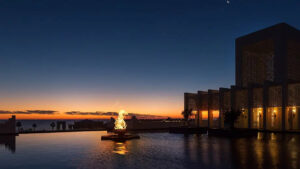
Arriving into Fez, I expected to find a city with as much hustle and bustle as Marrakech. I could not have been more wrong. The city was still busy of course, but beautifully preserved Madrasas and Moorish buildings, as well as traditional trades such as those practised in the Chouwara Tannery, really made me feel as though I had stepped back in time. Thankfully free of motorised vehicles, the streets and alleyways of the medina are filled with market sellers and working mules (that seem to come from behind you out of nowhere), and there is a tangible sense of centuries old history and culture to the place – hardly surprising given that Fez is home to the oldest university in the world. I stayed here at Riad Maison Bleue – views from its beautiful roof terrace across the ancient ramparts of Fez el Bali to the surrounding hills were stunning – but I also really liked the look of Riad Le Calife, a cosy, boutique-style retreat at the heart of the medina with colourful interiors and 19th century mosaic tile floors.
I then embarked on an epic road trip south through the Atlas mountains to the Sahara, a journey that my brilliant driver Fatah ensured was broken with pit stops to look for wild monkeys in the roadside cedar forests and to sample the delicious cherries of the Azru Valley. We eventually reached Erfoud, gateway to the Moroccan Sahara, where I spent a comfortable night at Kasbah Chergui before heading to a desert camp in the heart of the Erg Chebbi dunes. I had never seen a sand desert before, but listening to complete silence as the sun rose early the next morning, was an unforgettable experience.
The drive west from Erfoud to Skoura takes you across mile upon mile of stony wilderness concealing lush green oases that seem to appear on the horizon as if from nowhere. I also stopped at the impressive Ziz Gorges where the canyons drop sheer to the rivers below, before reaching Dar Ahlam in the early afternoon. This ultra chic and very exclusive desert retreat is set in rambling gardens and has no keys, no reception and no dining room – everything is tailored to guests’ specific requests. Rates here are equally exclusive, but there is another more affordable hotel nearby, Les Jardins de Skoura, with high ceilinged rooms and English-style country garden (along with a no-nonsense French owner) that will make you feel completely at home.
From Skoura, I headed west to Ouarzazate, home to some of the biggest film studios and most iconic set locations in the world – Ridley Scott’s Gladiator was filmed at Ait Benhaddou Kasbah to the north of the town, before turning north across the High Atlas to Marrakech. Arriving here after several days of relative peace in the ‘deep south’ was an experience in itself, but it was wonderful to return and to see again how modern and old co-exist in such a vital way without compromising the city’s history.
I revisited the ancient Koutoubia Mosque and the sacred Saadian Tombs, explored the colourful souks and spice markets, and bartered in the Jemaa El Fna square, but with the thermometer hitting 43C it was a relief to escape through the unassuming entrance doors of Les Jardins de la Medina into the cool of its palm-filled central courtyard. After a brief look around Riad Fenn (very smart, even by Marrakech’s standards), and a wonderful lunch of pastillas, salads and lamb tagine at Riad Kniza that I never thought would end, I headed back up into the High Atlas to enjoy the simple comforts of Kasbah du Toukbal. The Kasbah may only be an hour’s drive from the city, but the remoteness and beauty of the surrounding mountain landscapes made it feel a world away. It is the perfect place to relax and enjoy the spectacular views, but also to trek and ride through the surrounding hills in the shadow of the highest peak in the country, Mt Toubkal. I could have stayed for days! My final port of call was the Atlantic town of Essaouira, a former Portuguese colony that is now famous for its beautiful harbour and white and blue buildings. From the ramparts of the old fort, you look out over a wide sandy bay – an unbeatable view that was mirrored from the roof terrace of my delightful riad, the colonial-style Villa de l’O. Fairly busy in the summer with Moroccan families escaping the heat of the big cities, Essaouira still retains the old-fashioned charms of a traditional seaside town, but with plenty of water sports on offer and golf nearby.
I can highly recommend the little seafood shacks along the harbour wall where you can pick your own fresh fish seafood to be cooked right in front of you, and also the Resto La Toros where you can watch the sun set over the sea from its multi-level terraces right on the water’s edge. Besides the delicious food, the uninterrupted view of the ocean, sky and rocks was the perfect way to end my journey through Morocco.